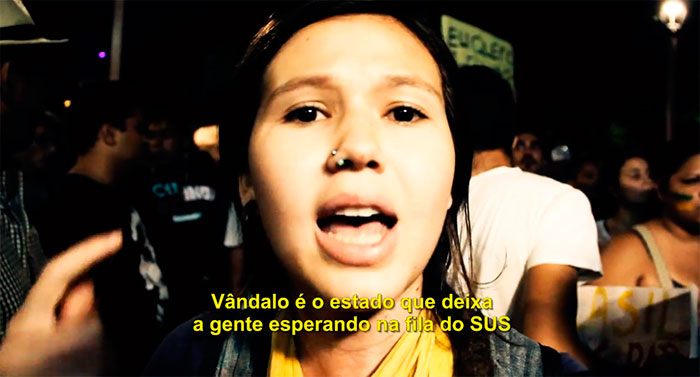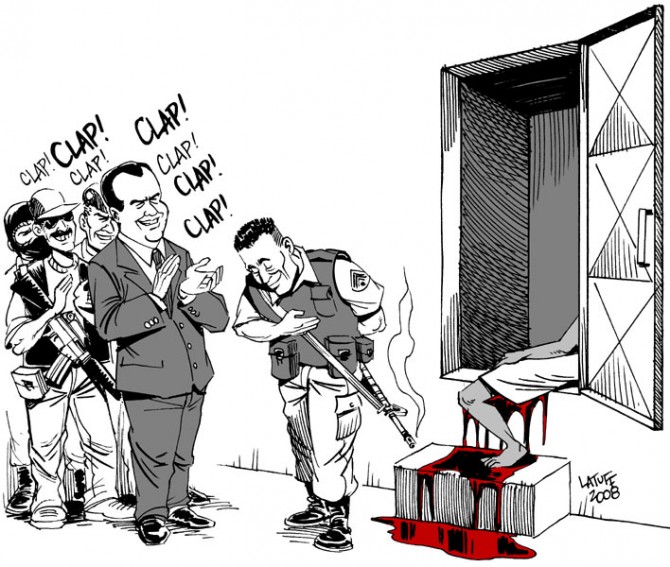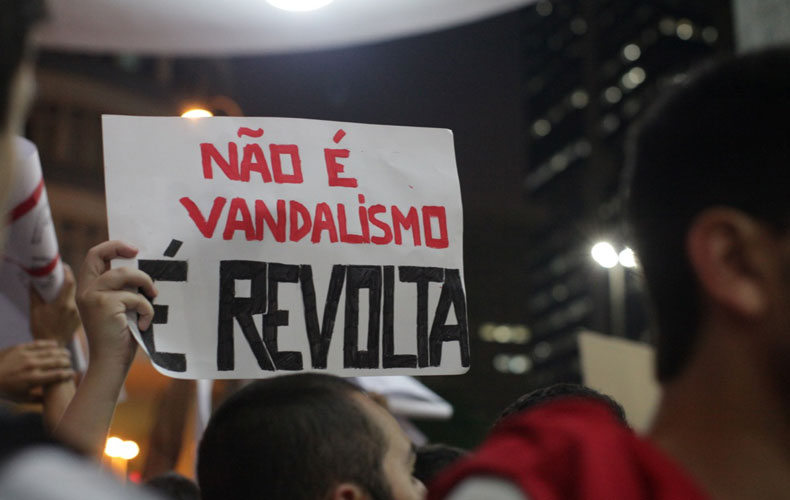Sunday July 13th 2014, Amsterdam – Com Vandalismo – Benefit Cinema for Rafael Braga, in Portugues with English subtitles. Door opens at 8pm, film begins at 9pm.
Com Vandalismo, Brasil, 2013, 72min, Directed by collective Coletivo Nigeria
This Sundays cinema is not only about screening a movie but also to collect some money for Rafael Braga, 26 years old, who used to live in the streets of Rio de Janeiro but had been arrested last year during the uprising protests against increasing transportation costs, the lack of basic social services and the effects of elitist mega events such as the World Cup. He has been sentenced to 5 years prison in December last year and needs financial support, as he has literally no means of defending himself in the court nor being supported in prison. Logical, skip the final match of this Copa and come to Joes instead. No one is left behind. All donated money will be send to the Cruz Negra Anarquista – ABC Rio de Janeiro.
Rafael Braga was arrested 20th of June 2013 during the protests of 300000 people in Rio de Janeiro. He carried two bottles of cleaning products and a wooden broom when leaving the abandoned shop where he used to live. He says that those tools are being used for his job as car and window cleaner but police took him into custody as they accused him to support protesters with materials for Molotov cocktails.
After waiting in custody for five month, he was sentenced to 5 years in prison by the court in Rio in December 2013. The judged argued that cleaning products could possibly being used as weapons that would cause damage of property and death of people and therefore determined a 4 years prison sentence. He added another year as Rafael had a “criminal” history for theft and already served prison sentences twice.
We want to support Rafael Braga with this screening, not only in terms of financial support but also by showing our solidarity and trying to raise awareness about his situation and the background that caused his custody.
Starting with the massive protests in Brasil last year, “Com Vandalismo” gives insights in the dynamics that emerged during the countrywide expansion of those protests. A possible ignition could most likely be the struggle against the increase of transportation costs in several cities like São Paulo, Natal, Rio de Janeiro, Goiana and Curitiba (just to name a few of them).
The struggle against the increase of ticket fares and the demand for unconditional free public transport has been initiated by “Movimento Passa Livre” (MPL), an autonomous and horizontally organized movement whose groups are independently active in several cities since 2005. The first bigger protest organized by MPL already took place in the city of Natal in Summer 2012 and spread to other cities in the course of the following months, reaching a peak in Summer 2013, especially in June and July, where several million people hit the streets in many cities all over the country. Since then, public protest is continuing and more visible during the current World Cup.
The struggle for free public transport seemed to have enabled a popular struggle of much a wider scope of demands, that expresses the peoples upset, anger and determination – for a radical change of the expensive public transportation system, that negatively affects all those whose only mean of transportation is public transport, that depend on commuting for hours from the peripheries of the cities to their low-wage jobs; that impedes the peripheries and people without money from accessing higher education by not being in the position to afford public transportation to the university districts as part of the overall study costs – for a better public education and health care system that benefits the working class and the people in the Favelas – for housing rights and self-determined housing construction – for an urban and land reform – for a radical change of the political system that is maintained by a reactionary and corrupt political class and the hated (military) police – against governmental and police repression of social movements and marginalized people and communities – for freedom of speech and freedom of personal expression.
“Com Vandalismo” analyses the governmental, mainstream press and police strategy to divide the protests and the protesters into “good” and “bad”: the police instrumentalizes even the smallest actions of activists to justify shooting with rubber bullets and tear gas grenades and denunciates non-pacific protest as sole “vandalism”, as non-political and anti-social. The police tries to hide its very own oppressive nature by claiming to act to protected private and public property against those “vandals”. Mainstream media jumps on that train and divides protesters into those with a legitimate cause and those that just want to “cause trouble”. This eventually leads to pacific activists blaming non-pacific activist to “destroy” the protest and giving the police a reason to intervene and even to the cooperation with the police by denouncing those “vandals”. In this way the state tries to weaken social struggle, as many divided and isolated groups are less strong as a mass that respects many forms and strategies of protests. “Com Vandalismo” illustrates the tensions and contradictions between the emancipatory elements of the protests and the nationalist notions of demands and actions.
The strategy of division has been announced by the Brasilian government in the end of 2013, particularly addressing the surveillance of “non-pacific” social movements that would cause cracks in the image of the idyllic mega event Copa. Surveillance is being accompanied by harsh police repression. Several activists have been arrested in Goiana and Curitiba in May this year for being active in the organisation of protests against the Copa and in the “Passa Livre” movement. Rafael Braga, has been arrested last year. Amarildo or André de Lima Cardoso or Pavão-Pavãozinho and more have been killed by the pacification units of Rio’s police.
Basically, the mega events Copa (2014) and Olympic Games (2016) are drawn on oppressive ground that is meant to criminalize dissent, social movements/struggle and the people that are living at the margins of the city and society. The pretext arguments of infrastructure improvements that are inevitably used to justify the realization of those mega events and the claimed boost of the local economy are benefiting just a fraction of society, mainly that, that is already privileged to afford tickets for the stadiums – while central city areas are being completely cleaned up and gentrified, eventually leading to the expulsion of those that cannot afford to live there anymore, away to more remote areas – while the (military) police is being equipped with better gear and weapons, is being trained in crowd control and counter-insurgency, is just there to be deployed against anyone voicing dissent.
For example, “kettling” a tactic to isolate and separate groups of demonstrators is well known and used among the riot police in many European countries and has been introduced during the anti-Copa protests in Brasil to control and demoralize large groups of protesters. Tear gas and shock grenades are shoot off en masse into the crowds on the streets, as well as rubber bullets. Cavalries and heavily armored (military) police units are deployed against the people by a state in state of emergency.
Systematic repression against marginalized people and social movements conducted by the government, the police and private militias is a well known reality for many years. During the looming Copa, Rio alone witnessed more then 20000 families being forcefully and violently evicted from the (central) Favelas in order to cleanup the city for the upcoming mega-events. During the last 6 years more then 200 of Rio’s Favelas have been occupied by 40 units of the special “pacification” police, the “Unidade de Polícia Pacificadora (UPP) consisting of more then 12000 cops. While claiming to protect the communities from drug cartels, to pacify the Favelas, to (re)establish an indefinite “public order”, the UPP itself is a violent actor accused for torturing, killing and threatening community members. A contradiction to pacify by furthering militarization, to (re)establish a “public order” that merely implies the state’s and parts of the publics intentional assessment that marginalized people are not being part of society, where the state’s only “visible” activity is ordering military police to kill drug dealers, to destroy informal settlements and occupations, or to let paramilitary squads within the (military) police arbitrarily kill community members.
Informal settlements and occupations are suffering for decades from a permanent and systematic police abuse as racist governmental, media and public discourses labels the predominantly dark skinned inhabitants as mere “criminals” and justify their oppression based on their own self-established “facts”. Just three weeks ago, on the 23rd of June, the inhabitants of several of Rio’s Favelas were calling for a demonstration entitled “A festa nos estádios não vale as lágrimas nas favelas” – “The party in the stadiums is not worth the tears in the Favelas” in order to denounce the states daily oppression.
This demonstration and the wide variety of other forms of protests and actions performed during the past months in many cities show self-determined people that do not just accept their “fate” but organize themselves to challenge the capitalist and neo-colonial status quo – several land occupations have been organized by landless workers movements – several buildings have been squatted by homeless workers movements – acts of resistance have been organized against evictions of occupied land – the campaign “http://www.portalpopulardacopa.org.br” – “Worldcup without people, we are on the streets again” and the international campaign “Não vai ter copa” have been started – attacks against police infrastructure and capitalist/neo-liberal symbols have been conducted worldwide – and countless other peaceful, non-peaceful, beautiful acts.
“Com Vandalismo” is another form of protest and refers to many of the previously mentioned aspects. Over the course of four days it draws on the tempted division of protest – the diversification of consciousness among the protesters – the peoples rage, anger and self-determination. It provides the links for a better understanding of the fate of Rafael Braga and many others that have already been detained, attacked, and wounded during the protests.
More infos, links and source: Joe’s Garage


